| Article ID | Journal | Published Year | Pages | File Type |
|---|---|---|---|---|
| 868772 | Biosensors and Bioelectronics | 2010 | 5 Pages |
In this communication we show that the achievable maximum current density for mature wastewater-based microbial biofilms is strongly dependent on the electrode material and the operation temperature. On graphite and polycrystalline carbon rods, the catalytic current of about 500 μA cm−2 (projected surface area) at 30 °C was achieved. Carbon fiber veil or carbon-paper based materials, having a large microbially-accessible surface gave a projected current density ∼40% higher than on graphite rod. In contrast, the biofilm cannot form well on graphite foil. Elevating the temperature from 30 to 40 °C increased current density by 80% on graphite rod anodes. Interestingly, the formal potential of the active site (−0.12 V (vs. standard hydrogen electrode (SHE))) is similar to all electrocatalytically active microbial biofilms and to that found for Geobacter sulfurreducens in previous studies. In addition, the real surface area values measured by BET surface area technique cannot provide a reasonable explanation for suitability of an electrode material for the formation of electrochemically active biofilm.
